Democrats Announce Qualifiers For First Debate
The participants for the two-night opening debate of the 2020 campaign season have been announced, and the candidates who were excluded aren't happy.
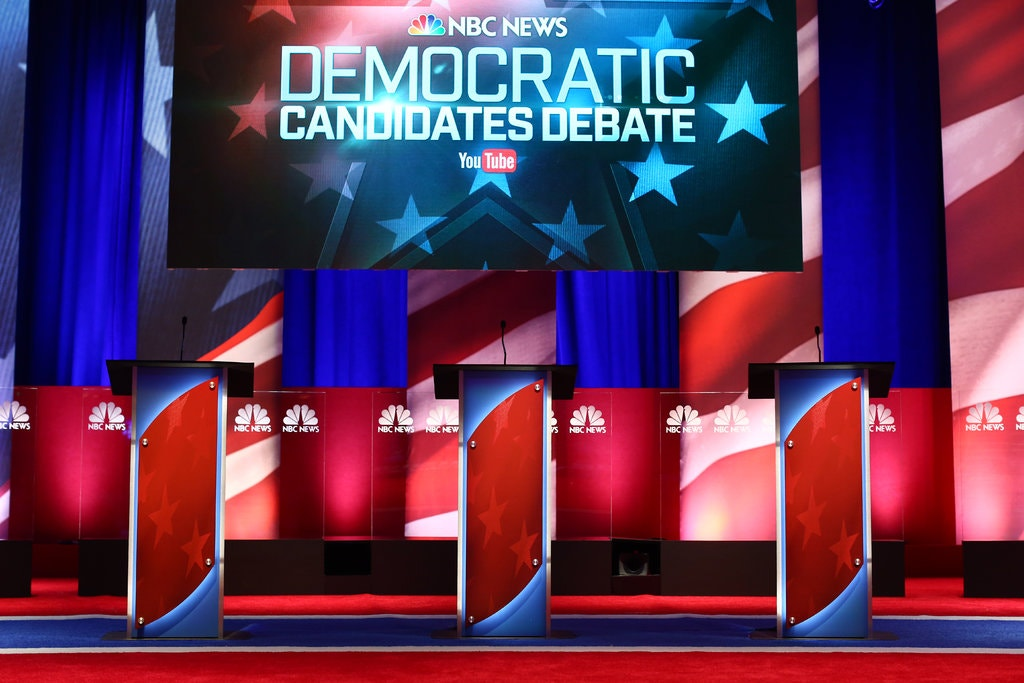
With the first round of debates between the Democratic candidates for President set for the end of the month, the Democratic National Committee has named the 20 candidates who will participate in the two-night event, and it’s already causing controversy:
The Democratic National Committee announced the candidates who qualified for the first debates of the 2020 presidential campaign on Thursday, chopping the historically large field of 23 contenders down to the 20 available slots.
Gov. Steve Bullock of Montana, Representative Seth Moulton of Massachusetts and Mayor Wayne Messam of Miramar, Fla., did not qualify, and will be left out of the debates on June 26 and 27 in Miami, according to a news release sent out Thursday night.
The candidates who made the cut — a full list appears at the end of this article — did so by registering 1 percent support in three polls, receiving donations from 65,000 people, or both.
To determine the 10-candidate lineup for each debate, the committee has said it will evenly and randomly divide top-tier candidates across the two nights. NBC News, which is moderating the first debates, will select the lineups on Friday.
The June debates will be the first time many Americans see the Democratic field. For candidates outside the top tier, the debates present a chance for a breakout moment — though they will have to fight for airtime with nine other people on the stage each night.
Mr. Bullock, who kicked off his campaign May 14, has been outspoken about his displeasure with the party and the methods it used to pare down the field. In emails to donors, he complained vociferously after a poll that would have helped qualify him for the debates was excluded from consideration. And on Thursday, Mr. Bullock’s campaign said it had lobbied the D.N.C. for inclusion in the debates one more time, arguing again that the disqualified poll should be counted.
Two other polls released this week gave Mr. Bullock a pair of additional chances to meet the threshold. Had he received 1 percent support in either of those polls, Mr. Bullock would have become the 21st candidate to qualify for the June debates, and that would have forced officials to employ tiebreakers to determine which candidate would be excluded.
In anticipation of Thursday’s bad news, he put out a statement emphasizing, as he has repeatedly over the past few weeks, that he had delayed entering the race in order to work with the Montana Legislature to renew the state’s Medicaid expansion.
“While 20 candidates are on the debate stage in Miami, I will be talking directly to voters about my record of passing progressive priorities in a state Trump won, the importance of winning the places we lost, and how we are going to beat Donald Trump once and for all,” Mr. Bullock said. 4
(…)
Mr. Moulton has yet to garner 1 percent of support in any qualifying poll since he began his campaign to become the Democratic nominee in April.
This week, a spokesman for the campaign declined to say how many people had donated.
“I knew that getting in so late that I’d probably miss the first debate,” Mr. Moulton said Thursday. “The DNC debates are not going to determine the nominee. The American people are.”
He added, “I recognize I have to play a bit of catch-up, but I don’t have any regrets for getting in late.”
Mr. Messam has also struggled to gain attention, having reached the 1 percent threshold in only one poll. The campaign did not respond to requests for comment this week about its fund-raising efforts and Mr. Messam’s status in the debates.
The twenty candidates who did qualify are as follows:
The 20 candidates who qualified, in alphabetical order, are: Senator Michael Bennet of Colorado; former Vice President Joseph R. Biden Jr.; Senator Cory Booker of New Jersey; Mayor Pete Buttigieg of South Bend, Ind.; former housing secretary Julián Castro; Mayor Bill de Blasio of New York; former Representative John Delaney of Maryland; Representative Tulsi Gabbard of Hawaii; Senator Kirsten Gillibrand of New York; Senator Kamala Harris of California; former Gov. John Hickenlooper of Colorado; Gov. Jay Inslee of Washington; Senator Amy Klobuchar of Minnesota; former Representative Beto O’Rourke of Texas; Representative Tim Ryan of Ohio; Senator Bernie Sanders of Vermont; Representative Eric Swalwell of California; Senator Elizabeth Warren of Massachusetts; the self-help author Marianne Williamson; and the former tech executive Andrew Yang.
Democrats in 2020 face much the same problem that Republicans did, perhaps even more extensively given that they are dealing with a field of 23 candidates where Republicans had, at the highest point, 17 credible candidates in the field. Obviously having all of these candidates on the debate stage at once is impractical so some decision had to be made about how to deal with such a large field of candidates vying for the nomination, especially in the early stages of the campaign.
In 2016, of course, Republicans dealt with the plethora of candidates by dividing their debates between a “main card” debate that aired in primetime and an undercard debate that was held two or three hours prior to the main debate. While both debates were aired by the network covering them on a given day, the main debate obviously received higher ratings and more attention than the debate featuring the “also ran” candidates. It was far from an ideal solution, but given the size of the field, it wasn’t entirely a bad idea about how to deal with an otherwise intractable problem.
The biggest problem with the undercard debate idea, of course, is that it really didn’t address the fundamental complaint of the lower-ranked candidates that they were being denied the media coverage that the participants in the “main” debate would get. In some cases, this was because some of these candidates, such as former Virginia Governor Jim Gilmore, didn’t qualify even for the undercard debate, but mainly it was because the undercard debates would typically be held before the main debate beginning around 6:00 p.m. Eastern time, a time when Americans in the eastern half of the country were still making their way home from work and Americans in the western half of the country were still at work. The main stage debates, meanwhile, typically didn’t start until 9:00 p.m. on the East Coast, meaning a much larger audience available to watch the debate. Additionally, while there was some movement between the two debate stages, for the most part, it was the case that candidates who got stuck in the undercard debate stayed there, although there were a few notable exceptions in candidates who got promoted or demoted based on the polls. In any case, the main/undercard debate format only lasted until roughly October of 2015 when debate organizers began excluding undercard participants entirely. Not surprisingly, most of those candidates ended up withdrawing from the race before anyone had even voted.
Instead of the main and “undercard” debate, Democrats are going with the idea of two-night debates where the participants would be selected somewhat randomly so that they would include both high-ranked and low-ranked candidates, thus at least theoretically making it less likely that the lower-ranked candidates would essentially be consigned to that status forever due to being included in a debate that nobody was watching. They are also apparently using criteria beyond polling, such as fundraising and other criteria, to determine debate eligibility. These criteria would include how organized candidates were in specific states, although it’s unclear how some of these criteria can be objectively measured.
While this plan is arguably better than the “main” debate and “undercard” idea that the Republicans had, it suffers from some of the same weaknesses. For example, how many people are actually going to watch two nights of debates, especially if the candidates they prefer all end up being in one debate rather than the other?
In any case, while Congressman Moulton and Governor Bullock both have valid arguments for why they should have been included, there does have to be a cutoff point. The rules that the DNC laid down aren’t perfect, but then nothing is likely to be completely satisfying to all the candidates.
Later today, we’ll learn which candidates end up on which night of the debate. Presumably, organizers will seek to spread out the frontrunners somewhat equally between the two nights of debates but it seems clear that some candidates are likely to attract a bigger audience, and thus provide a bigger advantage to the other candidates on the stage with them. This seems especially true of candidates such as former Vice-President Joe Biden, Senators Bernie Sanders, Elizabeth Warren, and Kamala Harris, and South Bend, Indiana Mayor Pete Buttigieg. If all those candidates were to end up together on one night it would likely mean lower ratings for the other night. In any case, we’ll see how that works out when the announcement is made before the close of business today.

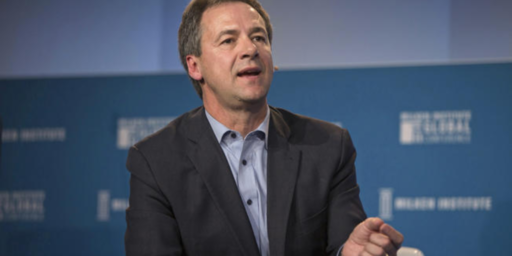
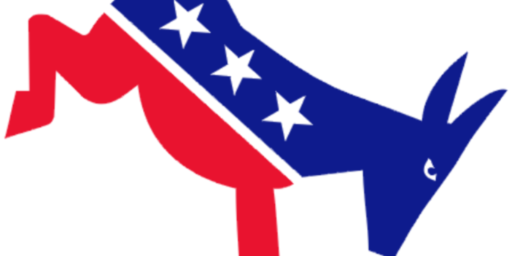
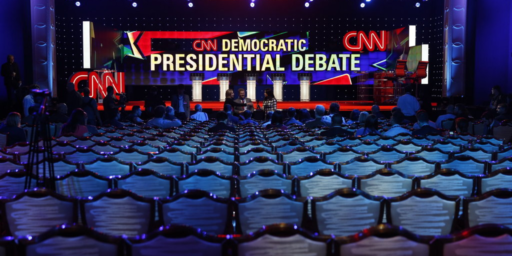
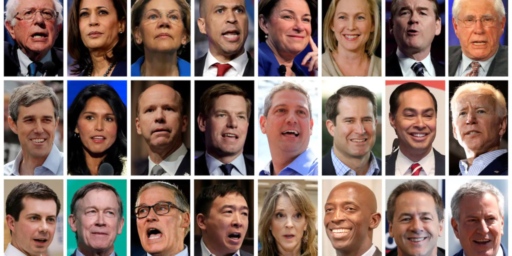
Television debates are an adequate medium for 2-4 contenders for a nomination making mini-stump speeches in response to softball questions from a newsreader moderator. It’s a lousy medium for 20 contenders. IMO it’s barely possible that an extremely deft moderator could make something out of it but I think the likelihood is that it will reveal the flaws in the system.
Maybe a friendly Deathball match would have been in order, and gotten better ratings.
@Kathy:
That would give Seth Moulton quite an advantage.
@Dave Schuler:
Buttigieg has the smaller frame, smaller target. And I have a hunch Tulsi is a scrappy fighter.
Mr. Bullock sounds like one of the students we were inflicted with in Physics 101 exams: “I realise I didn’t put anything down on my paper but I just zoned out and I don’t think it’s FAIR I didn’t get any points!”
(….undergrads…..sigh…)
They’ve now released the candidates for each night, and Warren will be surrounded by 1-2%ers on the first night, with the rest of the major candidates on night two.
Not great.
I know they used a threshold to divide the field into known and unknown, to try to avoid the kiddie table debate, but that threshold should have been higher than 2%.
Not great for Warren, not great for the 2%ers appearing with her who might also not get a chance to shine if viewers ignore the kiddie table debate. At least it’s the first night, so there is novelty.
@grumpy realist: Bullock got a late start since he was still working with his legislature, getting shit done.
That said, he should have started early anyway, even if not visiting early states often. He could have met the contribution threshold had he done so.
I hope he runs for Senate when/if this President thing fails to pan out. He has plenty of time.